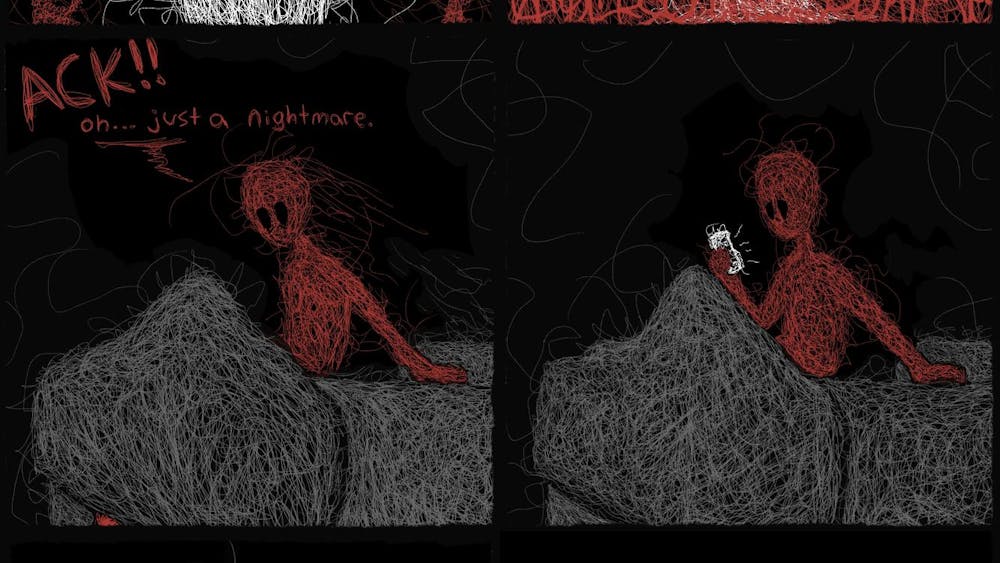Former Eastern Echo cartoonist and creator of Smile and Wag, Eric Muntz, has finished the first issue of his full-length comic series, “Wolfram: A Gothic Parable.”
Taking its influence from Gothic literature and Christology, the comic tells the story of Isolda, a Wolfram. The Wolfrim (plural) are a subset of the common werewolf, the difference being bloodlust. According to Muntz, werewolves were humans who, because of their bloodlust, became wolves by choice. Wolfrim are former werewolves who have chosen a righteous path, not unlike born-again Christians, to do right by God.
Muntz, a Baptist by affiliation, uses the Wolfram series as a vehicle to express his feelings about Christianity. “I am proud of the message of Christ,” he said, “but not of the way it was advanced to the world.” Recognizing that not all Christians throughout history have been bad, Muntz still feels ashamed of the violence associated with the religion through the ages.
Muntz uses the imagery of the werewolf, overcome by rage and bloodlust, to symbolize the world without a savior. In the first issue, “Wolfrim’s Lifeblood,” the only human featured in the story so far, Karsten, is ravaged by werewolves. Isolda, the Wolfram (reformed werewolf), happens to find him. She fights off the werewolves and attempts to save him.
As werewolves become Wolfrim, their blood becomes a sort of magical substance with healing power. As quoted in the story, Wolfrim blood “can heal any wound within one minute. It can restore any organ to wholeness.”
Injuring herself to retrieve the blood and save Karsten shows Isolda’s self-sacrificial determination to do the right thing. She saves Karsten, a stranger, out of the kindness of her heart—a representation of a devout Christian following the true word of Christ.
The story might seem confusing to some who have no prior knowledge of Gothic literature or Christology, but it makes for an interesting read. There is a foreword in the beginning of the comic to explain Muntz’s objectives with the story.
The series comes with a disclaimer: For mature readers only. Muntz’s detailed drawings tend to be somewhat graphic, depicting blood and violence. The nature of the story itself is not intended for children.
“Wolfram: A Gothic Parable” is a lengthy series still in the making. The first issue is the only one he has finished so far.
“The production is slow so the releases will probably be rather intermittent,” Muntz said. He plans to collect all of the issues, when the story is finished, into a four-volume set of graphic novels. “This probably will be a long time in the making.”
Muntz, having graduated from EMU last spring with a BFA in drawing, started the story while he was still in school, during the spring of 2010 and finally set to work on this version of the issue one year later.
This first issue of the series was originally set to be released on Dec. 31, but the process was slowed due to the holidays.
“I’m waiting to hear back from Comixpress.com,” Muntz said, referring to the website from which he had ordered prints of his comic to be made. “I’m waiting for [the story] to be added to their online store.”
While the story is not currently available for readers to purchase, Muntz does have a blog that documents the progression of the series. The blog also features a teaser of “Wolfrim’s Lifeblood” and will keep readers updated with news of the comic’s release.
Eric Muntz’s blog, “OpCode: Wolfram” can be found at http://wolfram-a-gothic-parable.blogspot.com.
However, readers should note: Due to his passionate disagreement with ACTA, the Anti-Counterfeiting Trade Agreement—a proposal to establish international intellectual property rights enforcement, Muntz will be blacking out his blog in solidarity with global internet protests. He has not set a date for this blackout yet.









